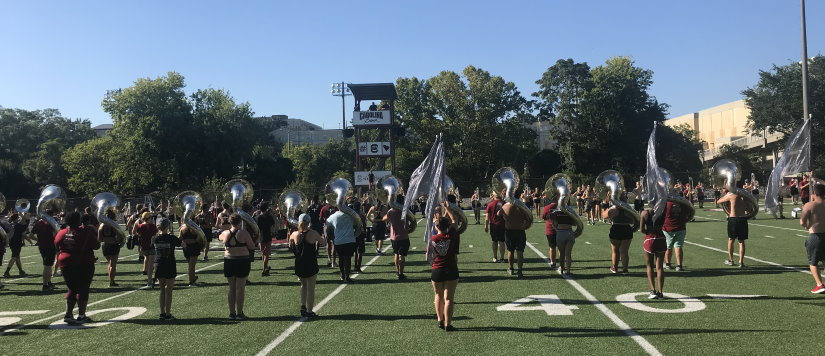September 20, 2019 | Erin Bluvas, bluvase@sc.edu
Researchers at the University of South Carolina’s Arnold School of Public Health and the University of Kansas have completed the first phase of a study examining the health effects of practicing or performing in high environmental temperatures among university marching band musicians. This research examined multiple aspects of heat-related illness, including hydration/fluid intake/thirst, gastrointestinal distress and core temperature.
“Marching band members practice at the same frequency and times of day as college student-athletes,” says Toni Torres-McGehee, associate professor of athletic training in the Arnold School’s Department of Exercise Science, who led the study along with athletic training associate professor Susan Yeargin and Ph.D. in Exercise Science alumna and University of Kansas assistant professor Dawn Emerson. “Exertional heat illnesses, dehydration, and low energy availability are prevalent in the college student-athlete population due to the rigors of pre-season and hot conditions, yet these conditions have not been described in the marching band population.”
An understudied form of organized physical activity, performing arts (e.g., marching band, dance, circus arts) often involve the same conditions and physical requirements as traditional sports. Torres-McGehee, Yeargin and Emerson came up with the idea for this study because they all have first-hand experience with marching bands and the challenges involved in practicing and performing in high temperatures. Yeargin and Emerson were marching band members in high school and/or college while Torres-McGehee served as the athletic trainer for the Million Dollar Band at the University of Alabama for three years.
Membership in university marching bands requires individuals to perform physical activity for several hours per day, often in high environmental temperatures. These musicians face physically active demands during both rehearsals and performances.
Previous research has demonstrated that marching band members experience exertional heat illness; however, these studies have not examined thermoregulatory responses and potential influence of environmental factors as well as unique variables associated with individual institutions. With this project, the researchers partnered with each institution’s School of Music, which are home to the universities’ athletic bands, including the marching bands.
At UofSC, the researchers worked closely with Cormac Cannon, associate professor of music. Since promoted to director of bands, Cannon served as the marching band director when the study began and proved to be a critical partner in making the project possible.
“We are always striving to improve the health and safety of our band members, so joining this study provided us the opportunity to learn more about how our activity affects their bodies,” says Cannon. “We hope to learn new and better strategies to help our students better prepare for the rigors of marching band in the heat, and ultimately have a more rewarding experience.”
In 2018, the team studied participants’ gastrointestinal distress – a common complaint among marching band musicians – including how factors such as core temperature, hydration, performance uniforms and environmental factors may play a role in these problems. The combination of dehydration and intense rehearsals and game performances in extreme temperatures may be the cause of GI distress, according to the scientists.
The majority of marching musicians reported GI distress, highlighting the importance of healthcare professionals working with these groups to take steps to minimize risks that have been associated with GI distress (e.g., inadequate hydration/dietary intake, stressors such as medication/poor sleep, exercising in hot/humid conditions). Further, both bands experienced hot environmental temperatures but varied in terms of rehearsal length, game times, and ground surface (concrete vs turf vs grass) that appear to influence physiological responses. Musicians in both bands reached high internal body temperatures (upwards of greater than 104F), highlighting the need for healthcare professionals to work with this population and implement safety strategies.
A second component of this study investigated hydration status, fluid intake, sweat and thirst among band members – another area that has been studied in athletes playing for long periods in high temperatures, but not yet examined among marching band musicians who rehearse and perform in the same conditions. Previous research has found that athletes who play in these conditions frequently begin and end activity dehdyrated. The researchers looked at whether hydration status varied according to event type and found that musicians were more dehydrated at games compared to rehearsals – likely due to uniforms (often made of heavy wool-blend fabric with plastic hats with no ventilation), hot outdoor temperatures, and carrying heavy instruments (e.g., drums, tubas) – all of which inhibit evaporative cooling.
“Marching band healthcare is an emerging setting for athletic trainers,” says Torres-McGehee. “Although our bands were different in terms of UofSC’s marching band having access to an athletic trainer and KU’s did not, the members still displayed heat-related risk factors. Thus in turn, having an athletic trainer, would allow additional education, prevention related to heat-related illnesses and immediate medical attention for medical emergencies related to heat.”
This fall, UofSC has continued this research with a second phase of the study, collecting data related to the effects of hydration, nutrition and other heat stress risk factors on physiological responses among marching band members. Like athletes, marching band members are at risk for inadequate energy intake due to the physical and environmental factors they encounter – leading to low energy availability (i.e., insufficient dietary intake to support required energy expenditure). As with the first phase of the study, the researchers hope that their findings will help inform clinicians and professionals who work with these students to help protect their health and wellbeing.
Related:
Toni Torres-McGehee receives Academic Leadership Development Program Alumni Fellowship from the SEC
